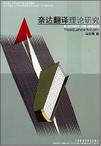奈达翻译理论研究
出版时间:2003-9 出版社:外语教学与研究出版社 作者:马会娟 页数:250
Tag标签:无
内容概要
《奈达翻译理论研究》对奈达的翻译理论作了较为全面、系统的研究,对译界对它的研究状况和接受情况进行了梳理、分析,澄清了译界对奈达理论的种种错误认识,探讨了译界围绕奈达理论进行的论争及其根源。《奈达翻译理论研究》以奈达理论指导下的(现代英文圣经)和(现代中文圣经)中的诸多译例论证了奈达理论对翻译实践,尤其是对外汉翻译实践的指导意义,证明了我国译界认为奈达理论不适合外汉翻译的观点是错误的。《奈达翻译理论研究》对奈达理论和金陧理论的异同之处及其原因进行了深入探讨,对金译
书籍目录
~CHAPI.ER ONE INTRoDUCTION1.1 REASONS FOR FURTHER RESEARCH oN NIUA’S TRANSLATION THEORY1.2 A PROFILEOFNIDA1.2.1 Nida’s Earlier Study1.2.2 His Involvement in the American Bihie Society1.2.3 His Academic Contributions to Modern Linguistics andTranslation Theory1.2.4 Nida’s Association with Chinese Translation Scholars1.3 A SURVEY OF NIDA’S TRANSLATION THEORY1.3.1 Nida’s Scientific Study of Tran~~ating1.3.2 The Principle of Dynamic Equivalence1.4 THE GUIDING PRINCIPLES OF THE RESEARCH1.5 THE METHODOLOGICAL APPROACHCHAPTER TWO REVlEWS OF NID A.S TRANSLATIoN THEORY2.1 A SURVEY OF CHINESE TRADITIONAL TRANSLATION THEORY BEFORE THE 1980S2.1.1 Debate over Literal and Free Translation ln Buddhist Translation2.1.2 Translation Principles in the Late Qing Dynasty2.1.3 The Dehares on“Fairbdufness”versus“Sraoothness” in the 1930s2.1.4 Translation Criteria Acknowledged from the 1940s to the 1960s2.1.5 Translation Studies During the“Cultural Revolution”2.1.6 The Features of Chinese Traditional Translation theories2.2 NIDAS TRANSLATION THEoRY IN CHINA2.2.1 Popularity of Nidgs Theory from 1981 to the Late 1980s2.2.2 Rethinking Nidas Theory from the Late 1980s through the Mid-1990s2.2.3 Denial of Nidas Theory from the Mid-1990s to the Present Time2.2.4 Problems in the Studies of Nidgs Theory in China2.3 AN OVERVIEW oF WESTERN TRANSLATION THEORIES REFORE NIDA2.3.1 Early Statements on Translation During the Period of Roman Empire2.3.2 From the Renaissance to the Eighteenth Century2.3.3 The Nineteenth Century2.3.4 The First Half of the Twentieth Century2.4 NIDAS TRANSLATloN THEORY IN THE WESTERN WORLD2.4.1 Influence ofNidasTheory2.4.2 Criticism of Nidas Theory2.4.3 Rejection ofNidgsTheory2 4.4 Problems in the Studies of Nidgs Theory in the WestCHAPTER THREE A STUDY ON NIDAS TRANSLATl0N THEORY3.1 NIDRS VIEWS OF LANGUAGE AND CULTURE3.1.1 NidgsView of Language3.1.2 NidasView ofCulture3.2 NIDAS SCIENCE oF TRANSLAIoN3.2.1 The Nature of Nidas Science of Translation3.2.2 The Distorted“Science of Translation”in China3.2.3 Nidas Science of Translation and ChomskCs TG Grammar3.3 NIDAS CONCEPT OF TRANSLATloN EQUIVALENCE3.3.1 Translation Equivalence in Western Countries3.3.2 Translation Equivalence in China3.3.3 Nidas Concept of Equivalence3.4 DYNAMIC EQUIVALENCE/FUNCTIONAL EQUIVALENCE3.4.1 Phase I Dynamic Equivalence and Formal Equivalence3.4.2 Phase II Dynamic Equivalence and Formal Correspondence3.4.3 Phase III:Functional Equivalence and Formal Correspondence3.5 CONTROVERSIES oVER DYNAMIC EQUIVALENCE/FUNCTIONAL EQUIVALENCE3.5.1 Dynamic Equivalence and Reader-Response Theory3.5.2 Content and Form3.5.3 Naturalization and Foreignization3.6 TESTING NInAS THEORY WITH SPECIAL REFERENCE TO BIBLE TRANSLATIoN3.6.1 The History of Bible Translation into English3.6.2 Testing Nidgs Theory with Examples from Todays English Version3.6.2.1 Translating Idioms3.6.2.2 Reconstructing Formal Structures3.6.2.3 Translating Figurative Expressions3.6.2.4 Making Explicit Implicit Information3.6.3 The History of Bible Translation into Chinese3.6.4 Testing Nidgs Theory with Examples from Todays Chinese Version3.6.4.1 Translating Idioms3.6.4.2 Reconstructing Formal Structures3.6.4.3 Translating Figurative Expressions3.6.4 4 Making Implicit Information Explicit3.6 5 Problems in the TEV andtheTCVCHAPTER FOUR A CoMPARATIVE STUDY OF NIDAS THEORY AND JIN DIS THEORY4.1 JIN DI’S TRANSLATl0N THEORY4.1.1 A Survey of Jins Translation Activity and Translation Study4.1.2 Jins View on Translation Before His Reception of Nidas Theory4.1.3 Jins Theory of Equivalent Ef~~ct and Its Relationship with Nidas Theory4.2 RETHINKING NIDA’S DYNAMIC EQUIVALENCE4.2.1 The Relationship between Dynamic Equivalence and the Principle of Equivalent Effect4.2.2 The Scientific Basis of Dynamic Equivalence/Functional Equivalence4.2 3 The Immediate Concern of Dynamic Equivalence4.3 JINS RoLE IN PoPULARIZING NIDAS THEORY4.3.1 Jins Contribution to a Better Understanding of Nidas Theory4.3.2 Problems with Some of Jins Views about Nidas Theory4.4 DIFFERENCE BETwEEN JIN’S THEoRY AND NIDAS THEORY4.4.1 Reader-Oriented vs Text-Oriented4.4.2 Flexible vs Inflexible4.4.3 Ideal Objective vs Realistic Goal4.4.4 Reasons for the Differences between Jins Theory and Nidas Theory4.5 COMMENT ON JINS CHINESE VERSION OF ULYSSES4.5.1 Successful Representation of Stream of Consciousness4.5.2 Successful Representation of Normal Narratives4.5.3 Problems in Jin’s Chinese Version of Ulysses4.5.4 Implications of Jins Translation Practice for the Applicability of Nidas Theory to Literary TranslationCHAPTER FIVE ATIlEMPTS TD FURTHER AMEND NIDAS TRANSLATlON THEORY5.1 THE APPLICATIONOF NIDAS THEORY TO LITERARYTRANSLATIoN5.1.1 The Application of Dynamic Equivalence5.1.2 The Significance of the Concept of the Decoders Channel Capacity5.1.3 The Important Role Receptors Play in Evaluating Literary Translation5.2 THE LIMITATIoNS OF NIDAS THEORY IN LITERARY TRANSLATION5.3 THE IMPORTANCE OF TRANSFERRING AESrHETIC VALUES IN LITERARY TRANSLATl0N5.4 TRANSFERRING AESTHETIC VALUES IN LITERARY TRANSLATION5.4.1 Transferring Formal Aesthetic Mafres5.4.2 Transferring Non-formal Aesthetic Markers5.4.3 Transferring Aesthetic Values of a Literary Text as a Whole5.5 TESTING THE REPRESENTATION OF AESTHETIC VALUES IN LITERARY TRANSLATION5.5.1 Objective Factors Partiality of Translation5.5.2 Subjective Factors the Translator and the Reader5.5.3 Questionnaire Analysis of Literary TranslationCHAPTER SIX CONCLUSIONNOTESAPPENDIXBIBLIOGRAPHY~
图书封面
图书标签Tags
无
评论、评分、阅读与下载
用户评论 (总计3条)
- 拿到后翻了一下,书皮掉了,再看了没有几页,书散成一片一片了,去打印部定了,这方便失望。但是,从内容上来讲,这本书真的对研究奈达理论,欲完成论文的学生太有必要了。它可以在理论上给很大的帮助。好书,值得阅读研究。
- 写毕业论文用,应该会有用
- wonderful, that\'s just what I want, ***e it very much!!!!
推荐图书
- 电气设备运行维护及故障处理
- 管理信息系统
- 数据库管理与应用开发技术
- 电力生产安全技术及管理
- 行为科学
- 内科学
- 病理学
- 敢拼就会赢
- 需求工程
- 计算机网络
- MBA入学考试管理案例分析精粹100例
- 2012年全国中级统计师考试教材+习题(第二版)初中级
- 平面设计与印前处理
- Cimatron E操作技术――基础篇(附1光盘)
- Visual J#.NET技术内幕
- Visual C++6.0实用教程
- 操作系统实用教程
- Visual Basic.NET网络数据库程序设计
- 全国计算机等级考试
- WPS Office 2003实用培训教程
- Java课程设计
- Pro/ENGINEER英文野火版教程
- C/C++程序设计教程
- 高等学校英语应用能力考试最新备考指南
- 证券投资技术分析
